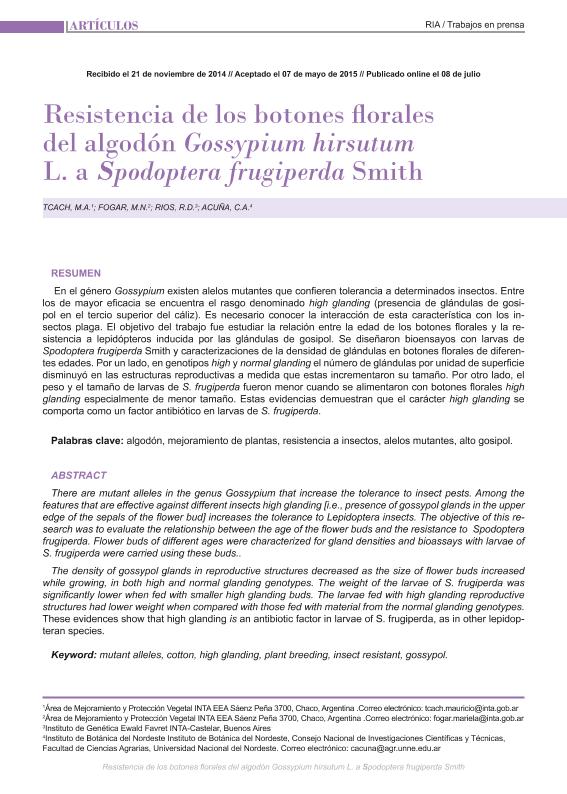Artículo
En el género Gossypium existen alelos mutantes que confieren tolerancia a determinados insectos. Entrelos de mayor eficacia se encuentra el rasgo denominado high glanding (presencia de glándulas de gosipolen el tercio superior del cáliz). Es necesario conocer la interacción de esta característica con los insectosplaga. El objetivo del trabajo fue estudiar la relación entre la edad de los botones florales y la resistenciaa lepidópteros inducida por las glándulas de gosipol. Se diseñaron bioensayos con larvas deSpodoptera frugiperda Smith y caracterizaciones de la densidad de glándulas en botones florales de diferentesedades. Por un lado, en genotipos high y normal glanding el número de glándulas por unidad de superficiedisminuyó en las estructuras reproductivas a medida que estas incrementaron su tamaño. Por otro lado, elpeso y el tamaño de larvas de S. frugiperda fueron menor cuando se alimentaron con botones florales highglanding especialmente de menor tamaño. Estas evidencias demuestran que el carácter high glanding secomporta como un factor antibiótico en larvas de S. frugiperda. There are mutant alleles in the genus Gossypium that increase the tolerance to insect pests. Among the features that are effective against different insects high glanding [i.e., presence of gossypol glands in the upper edge of the sepals of the flower bud] increases the tolerance to Lepidoptera insects. The objective of this research was to evaluate the relationship between the age of the flower buds and the resistance to Spodoptera frugiperda. Flower buds of different ages were characterized for gland densities and bioassays with larvae of S. frugiperda were carried using these buds.. The density of gossypol glands in reproductive structures decreased as the size of flower buds increased while growing, in both high and normal glanding genotypes. The weight of the larvae of S. frugiperda was significantly lower when fed with smaller high glanding buds. The larvae fed with high glanding reproductive structures had lower weight when compared with those fed with material from the normal glanding genotypes. These evidences show that high glanding is an antibiotic factor in larvae of S. frugiperda, as in other lepidopteran species.
Resistencia de los botones florales del algodón Gossypium hirsutum L. a Spodoptera frugiperda Smith
Fecha de publicación:
07/2015
Editorial:
Instituto Nacional de Tecnología Agropecuaria
Revista:
Revista de Investigaciones Agropecuarias
ISSN:
0325-8718
e-ISSN:
1669-2314
Idioma:
Español
Tipo de recurso:
Artículo publicado
Clasificación temática:
Resumen
Palabras clave:
Algodón
,
Resistencia a Insectos
,
Alto Gosipol
,
Alelos Mutantes
Archivos asociados
Licencia
Identificadores
Colecciones
Articulos(IBONE)
Articulos de INST.DE BOTANICA DEL NORDESTE (I)
Articulos de INST.DE BOTANICA DEL NORDESTE (I)
Citación
Tcach, M. A.; Fogar, Mariela A.; Rios, R. D.; Acuña, Carlos Alberto; Resistencia de los botones florales del algodón Gossypium hirsutum L. a Spodoptera frugiperda Smith; Instituto Nacional de Tecnología Agropecuaria; Revista de Investigaciones Agropecuarias; 41; 2; 7-2015; 161-167
Compartir




